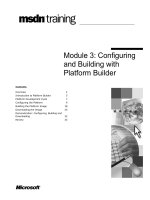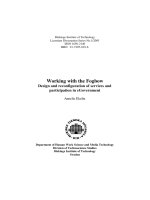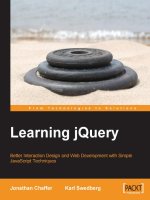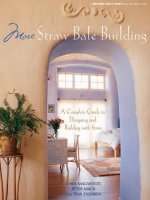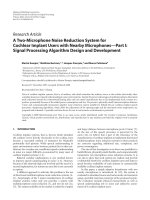Design and building with bamboo
Bạn đang xem bản rút gọn của tài liệu. Xem và tải ngay bản đầy đủ của tài liệu tại đây (4.21 MB, 211 trang )
Designing
andBuilding
withBamboo
Jules J.A. Janssen
Technical University of Eindhoven
Eindhoven, The Netherlands
TECHNICAL REPORT NO. 20
1
designing and building with bamboo
© International Network for Bamboo and Rattan 2000
All rights reserved. No part of this publication may be reproduced or transmitted in
any form or by any means, electronic or mechanical, including photocopy, recording or
any information storage and retrieval system, without permission in writing from the
publisher.
The presentation of material in this publication and in maps that appear herein does not
imply the expression of any opinion on the part of INBAR concerning the legal status
of any country, or the delineation of frontiers or boundaries.
ISBN 81-86247-46-7
Editor
Arun Kumar
Design and production
Art Options
2
Acknowledgements
i
In the 26 years of working with bamboo, I have met several good people, working in the
field of bamboo, from all over the world. Many of them have become my cherished
friends. First among these are those from the National Bamboo Project (later Funbambu)
in Costa Rica; I could list enough names to fill up this page. Apart from these Costa
Rican friends, I will mention here only four people: Wim Huisman, my professor and
first promoter; Walter Liese, who was a member of my Ph.D. committee and with whom
I have spent many enriching hours working on bamboo in several places; Ramanuja
Rao, with whom I have had as close a working relationship as two scientists can have;
and Arun Kumar, who has done a tremendous editing work on the typescript of this
book. I would also mention here that this book would never have been written but for
the understanding and support of my wife Loek.
J.J.A. Janssen
3
designing and building with bamboo
4
Preface
o
Over the past few years, several friends and peers had suggested that I write a book on
building with bamboo. Each time such a suggestion was made, I used to recall the wise
words of a professor who was famous for his lectures. Whenever pressured to write a
book based on his brilliant lectures, he used to decline, saying: “If I present my lectures,
my students will hear also my uncertainties, my doubts, the limits of science; but if I
were to write them down, then these are exactly what would become invisible.”
Then, why did I write this book now? There were some very persuasive arguments
from certain quarters in favor of writing it. One was that the insights and knowledge on
bamboo collected during my 25 years of research, guidance of projects and visits to
bamboo-growing countries all over the world should not be allowed to go unrecorded.
Another was that other areas – timber, for example – too started in a similar way with
one author writing a book while the area was still small enough to be captured by the
efforts of one. Finally, I thought that some information contained in my large collection
of gray literature should be revealed to all interested researchers.
This book has its origin in an e-mail I received in December 1996 from the Hawaii
Chapter of the American Bamboo Society, with an invitation to present a series of lectures
on all aspects of bamboo. An exchange of ideas followed through several e-mails about
the scope of the lectures, the topics to be covered and the time to be spent on each. It
was decided that an emphasis should be laid on bamboo’s mechanical properties, joints
and structures. I spent a considerable part of January-June 1997 preparing lecture
materials and charting out the course.
5
designing and building with bamboo
I reached Hawaii in July, and spent the first two weeks presenting summaries of the
lectures in three minor islands. On the third week, on the Big Island, the tempo really
picked up. The event started with a demonstration on bamboo jointing to a large audience.
This was followed by a three-day seminar, with six hours of lectures each day, involving
a large group of participants whose enthusiasm and dedication were contagious. Over
150 people had assembled there, paying on their own for travel and accommodation,
and listening to lectures on bamboo six hours a day for three days!
The effort that went into the preparation of that lecture series culminated in this book.
It took some time to bring the lectures into the shape of chapters, but doing that has
given me a great sense of satisfaction. I hope the readers will find this result of my
endeavors useful and interesting. I thank the Hawaiian Chapter of the American bamboo
Society without whose invitation to lecture this book might never have been.
Although the emphasis here is on designing and building with bamboo, I have included
two chapters – on Technology Transfer and Job Creation – so that the publication
provides a wider perspective on bamboo. I believe that this should be so because bamboo
is not just a plant or a material; in many parts of the world, bamboo is a vital part of the
living heritage that links yesterday with tomorrow.
Jules J.A. Janssen
6
Contents
1. Introduction
The Bamboo Plant
Bamboo in its Setting
The Structure of Bamboo
Competitiveness of Bamboo
Mechanical Properties
Uses of Bamboo
9
10
12
16
17
21
25
2. Plantations
Forests, Homesteads and Plantations
Ecological Aspects of Bamboo Plantations
Plantation Management
33
34
39
43
3. Durability and Preservation
Natural Durability
Fundamental Rules
Bamboo and Preservation
51
52
54
56
4. Mechanical Properties
Bamboo, a Hollow Tube
Nature’s Structural Design
Bending Tests
Bamboo and Shear Stress
Wind Load on Bamboo Culm
Compression Test
Bending vs. Shear
Buckling
Rules of Thumb
Earthquake Resistance
63
64
66
66
68
70
71
74
76
76
77
7
designing and building with bamboo
5.
Modelling and Calculations
The Art of Modelling
Allowable Stresses
Design of Joints
Building on Tradition
79
80
81
83
87
6.
Joints
Classification of Joints
Some Examples
Theory of Joints
89
90
108
112
7.
International Standards
The Relevance of Standards
Towards an International Standard
117
118
120
8.
Bamboo as Reinforcement
Fiber Reinforced Cement Mortar
Bamboo Reinforcing in Concrete
Bamboo for Formwork
Soil Reinforcement
127
128
130
133
133
9.
Bamboo Housing
Social Aspects
Technical Aspects
Guidelines for a Housing Project
137
138
145
163
10. Transfer of Technology
The Context
The Means
165
166
166
11. Job Creation
Bamboo Craft
Bamboo and Sustainable Development
Bamboo and Employment
171
173
175
176
12. Costs and Benefits
Bamboo Plantation
Bamboo Enterprise
181
182
185
References
189
Further Reading
197
8
Chapter One
Introduction
9
designing and building with bamboo
t
TheBambooPlant
In their natural habitat, bamboo plants grow from seeds or rhizomes. The rhizome
system is very important to bamboo. As bamboo does not have a central trunk as in
trees, the rhizomes provide the foundation. McClure (1966) has described the bamboo
rhizome as a segmented (with nodes), complex subterranean system. Bamboo rhizomes
can be broadly classified as pachymorph (sympodial) or leptomorph (monopodial). In
pachymorph rhizome system, the apex of a rhizome gives rise to a shoot that grows
into a culm, the woody stem of bamboo. Such culms grow close together as a clump. In
leptomorph rhizome system, the lateral bud from each internode develops into a culm
or a rhizome. As the apex of the rhizome grows horizontal to the ground, the clump of
monopodial bamboos has a spreading habit, with each culm growing at a distance from
the other.
Fig. 1 shows on the left a young shoot, protected by a series of sheaths, which will fall
off as the shoot grows into a mature culm. In many cases, these protective culm sheaths
are covered with tiny hairs sharp enough to pierce human skin and, in several species,
toxic enough to cause skin irritation. Most bamboos are hollow, as can be seen in
Fig. 1 (on the right). In the hollow inner area, some horizontal partitions called
“diaphragms” can be seen (towards the bottom on the right-side picture). On the
outside, these partitions are denoted by a ring around the culm. A diaphragm and the
ring on the outside together form a “node”. Branches grow from these nodes. The part
between two nodes is called an “internode”. The internodes of most bamboos are
hollow; that is, they have a “cavity”. The wall of the culm is called simply the “culm
wall” (Fig. 2).
In general, bamboo species have luxuriant foliage: the plant is one of the top producers
of biomass, producing about 10 tons per hectare. According to an estimate, bamboo
accounts for one-quarter of the biomass in tropical regions and one-fifth in sub-tropical
regions.
10
Fig. 1: A young bamboo shoot – outside (left) and inside (right)
(From CIBA Review, 1969, No. 3, p. 7; by permission of the Company Archive of Novartis AG, Basel, Switzerland)
4
1
2
3
4
6
5
Fig. 2: The parts of a culm
(1 = diaphragm; 2 = ring; 3 = node; 4 = internode; 5 = culm wall; 6 = cavity)
11
designing and building with bamboo
Fig. 3: Bamboo in landscaping (Japan)
BambooinitsSetting
Bamboo has the remarkable ability to create an “ambient”, in the artistic sense of the
term. Fig. 3 shows how bamboo can set the tone of a landscape. It forms a marvellous
contribution to the beauty and an improvement to the environment (bamboo’s role in
the environment will be discussed in detail in Chapter 2). The beautiful composition of
leaves and culms, often in rich colors, has inspired poets and painters from the ancient
to the modern times. In many modern shopping centers and office buildings around
the world, bamboo’s stately elegance makes it a cherished component of architectural
design. A harsh winter can severely harm bamboo because it is a plant for tropical and
sub-tropical environs. But even in countries with cold climates – such as the Western
European nations and the US – bamboo can be found in many gardens and parks as the
bamboo lovers in these places seem to have developed an instinct for growing species
that can survive cold winters.
12
introduction
A bamboo grove or plantation can be viewed as the production site of a building and
engineering material; but it is also a haven for the living. Many birds build their nests on
bamboo, and one can easily meet among bamboos animals like an iguana or an armadillo,
or the smaller ants, snakes and scorpions. In a forest setting, larger animals such as
panda, orangutan and elephant frequent bamboo stands. Some rare flowers, herbs and
mushrooms can be found inside bamboo groves, the edible “princess fungus” that
contains 21 amino acids being one example.
One must not forget to adequately emphasize bamboo’s role as a means for erosion
control, riverbank protection, landslide prevention and land rehabilitation. Bamboo’s
extensive network of rhizomes and roots binds the top one foot of soil, which is critical
for land productivity (Fig. 4), and effectively resists erosion by forces of nature such as
wind and water. There are cases reported wherein bamboo was planted to successfully
prevent the erosion of a riverbank and thus protect a village from being washed away.
Fig. 4: The root system of bamboo (the white scale is 150 mm long)
13
designing and building with bamboo
Fig. 5: Sasa bamboo, the green cover
When the bamboos had grown, not only the village was safe but also the villagers were
able to sell the culms and make a profit (Singh 1995).
There are some species of bamboo that can very effectively provide a green cover for
the earth and protect the soil. Sasa bamboo (Fig. 5), for example, is about 100-200 mm
high and is ideal for covering an area to protect it from erosion and sunburn. Its numerous
roots keep the soil together, while its leaves protect the soil against the sun. It will also
improve the soil through the biomass produced: the blanket of fallen leaves is effective
mulch to keep the moisture in and an organic fertilizer to rejuvenate the soil.
14
Fig. 6: A field in Costa Rica being readied for bamboo propagation
While most plants are multiplied by seeds, bamboo is an exception. In general, plants
flower at least once a year to produce seeds. But most bamboos flower rarely – once in
a period varying from 15 to over 100 years. It is not practical to wait that long for
propagation and therefore, bamboo is propagated mainly through cuttings. One place
where green culms are extensively used for cuttings is Costa Rica (Fig. 6). Here, green
culm lengths, with branches trimmed, are put horizontally on the soil. After 2-3 weeks,
new sprouts start to grow at nodes, where a branch has been trimmed. Each sprout will
have a root growing downwards and a shoot upwards. After some time, the original
culm can be cut into pieces and all young sprouts replanted in a nursery. In Asia, culm
cuttings are two or three internodes long. These are planted vertically into the soil, with
one node deep into the soil. Roots will start growing from the lower node, and branches
will sprout from the upper ones. Other methods that are in practice in different parts of
the world include offset method, rhizome method, layering, macroproliferation and
tissue culture.
15
designing and building with bamboo
TheStructureofBamboo
The microstructure of culm wall can be seen in Fig. 7. The outside of the culm wall (left
side of the picture) is dense, as can be seen from the dark color, and only about a quarter
of a millimeter thick. This layer contains much silica, a good material to protect the
plant, but a nuisance for tools as silica blunts their sharp edges within a short time. The
dark spots, decreasing from left to right in the cross-section, are cellulose fibers together
with vessels. Cellulose acts as reinforcement, similar to steel bars in reinforced concrete
or glass fiber in fiber-reinforced plastic. These fibers are concentrated near the outside.
The stiffness (the resistance against bending) that this distribution pattern creates is
ten percent more than the one that a more even distribution pattern could offer – an
excellent example of the structural design acumen of Mother Nature (imagine a steel
Fig. 7: The structure of bamboo (specimen size is 6 x 6 mm)
16
introduction
tube with high tensile steel on the outside and normal mild steel on the inside!). The
vessels take care of the transport of liquids during the life of the bamboo. The material
between the dark spots is called “parenchyma”, and it is the matrix in which the fibers
are embedded (like the concrete between the steel bars). Approximately, a bamboo
culm has 40% fibers, 10% vessels and 50% parenchyma.
While inspecting the structure of bamboo, one aspect readily catches our attention:
bamboo does not have any “rays” like the ones present in wood (best seen in woods like
beech as dark spots on the surface of a sanded plank). Rays are places for the transport
and storage of food, mostly sugar, but they weaken the material. Consequently, bamboo
is stronger than wood, especially in shear (this will be discussed in detail in Chapter 4).
CompetitivenessofBamboo
There are several plantations in bamboo-growing countries where bamboo is harvested
just like timber (Fig. 8). However, can one expect bamboo to be as economically
competitive? A simple calculation will explain this. Assume the approximate price of an
8-meter bamboo culm to be US$ 1.50. If the volume of woody material in the culm –
taking into account only the culm wall and not the cavity inside – is calculated, this
price would be US$ 105 per cubic meter. It has been verified that, because of its
hollowness, bamboo’s effectiveness as a beam is 1.9 better than a wooden beam. Hence,
for wood to be economically as competitive as bamboo, it should not cost more than
US$ 105 4 1.9 = US$ 55 per cubic meter. However, wood used for beams costs much
more than this, emphasizing the competitiveness of bamboo in structural use.
In most of the bamboo-growing countries, trade in bamboo culms is well established.
For example, about 25 million bamboo culms arrive every year in the dock seen in Fig.
9 from the northern part of Bangladesh. These come as rafts floating down the river, a
transportation process that lasts about three weeks. During this time, the transportation
crew lives in the hut set up on top of the raft. Fig. 10 shows a regular wholesale market
where the bamboo culms traded. Here, culms are segregated according to their thickness,
straightness, etc. for sale to building contractors and others.
17
designing and building with bamboo
Fig. 8: Harvested bamboo culms in a plantation in China
When considering a material for structural use, the first question that arises is about its
safety. Fig. 11 shows a comparison between bamboo, timber, steel and concrete in terms
of their behavior under stress. The stresses, with the symbol “s” (pronounced “sigma”),
are plotted on the horizontal axis. To make stresses between these different materials
comparable, the value of the stress in the material when the building is in normal use is
taken as the unit. This is indicated by the term “s use” (also called the “allowable stress”)
and is about 140 N/mm2 for steel and 10 N/mm2 for timber. In each of the three diagrams
in Fig. 11, a formation like a hill can be seen. This is the area of stresses at failure during
18
Fig. 9: A dock near Dhaka, Bangladesh, from where bamboo culms are transported
Fig. 10: A wholesale bamboo market near Dhaka, Bangladesh
19
designing and building with bamboo
tests, the middle part of the “hill” indicating the mean stress at failure (denoted by “s
mean”). Each hill also shows an “s” value, which is the standard deviation indicating
whether the results of a test are widespread or not. Technicians consider the stress
under which 5% or 2.5% of the specimens fail as the limit, and the allowable stress shall
be at a safe distance below this limit. These limits are indicated as s5% or s2.5%. On
the vertical axis, we see the value “p”, which is the chance that a stress will occur. If a hill
is wide and flat, the “p” is low; if a hill is narrow and steep, the “p” is high.
The lowest diagram is for steel, a material that is produced using a very controlled
process and hence, bad specimens are very rare. It shows a narrow and steep hill, indicating
p concrete
s
s 5%
suse
smean
p wood/bamboo
s
s 5%
suse
p steel
s
suse s2.5% smean
Fig. 11: A comparison of safety of bamboo and other materials
20
smean
introduction
that failure under stress occurs in a narrow range indicated by a small value for “s”. This
means that the allowable stress (“s use”) can be at a short distance from the stress at
failure. The diagram in the middle for wood and bamboo, which are natural materials,
shows a wide variety of stresses around the mean stress at failure. In these materials,
specimen quality varies widely from very bad to very good. Because of this uncertainty,
one finds a large distance between the stress at failure and the allowable stress. The top
diagram is for concrete, which is between the other two as far as safety is concerned. In
normal circumstances, the use of steel is economical because of the short distance
between allowable stress and stress at failure, signifying the optimum use of the material.
The use of timber and bamboo, on the other hand, is less optimal since the allowable
stress is very low when compared with stress at failure.
In the case of a disaster like a hurricane or an earthquake, however, the stresses will get
multiplied. They may become double the allowable stress. In such cases, stresses in
steel will come into the area of failure, but not in timber and bamboo. This means that
steel structures will suffer much damage, while most structures of timber or bamboo
will remain in good condition. A bamboo house is a good place to stay during a hurricane
or an earthquake (provided the house has been built with proper care).
Another comparison between the materials is shown in Fig. 12. Two questions are dealt
with here – how much strength and how much stiffness (resistance against deformation)
does concrete, steel, timber or bamboo give? The diagram shows that, as far as strength
is concerned, concrete is the worst, followed by timber (the green bars in the diagram
are calculated as the strength divided by the mass per volume or the density). Steel is
the best and bamboo the second best. In terms of stiffness, the fourth place is for
concrete, third for timber, second for steel and the first place is for bamboo (the brown
bars in this diagram are calculated as the E-modulus divided by the mass per volume or
the density).
MechanicalProperties
Mechanical properties will be dealt with in detail later, and the following is only a short
introduction. The most important mechanical property is the mass of the material per
21
designing and building with bamboo
strength/mass per volume
stiffness/mass per volume
concrete
steel
wood
bamboo
Fig. 12: Strength and stiffness comparison
unit volume (which is the density) expressed usually in kg/m3. For most bamboos, the
density is about 700-800 kg/m3, which varies with the quality of the site of growing, the
species, the position in the culm, etc. Why is this property important? The greater the
mass per volume, the heavier the bamboo because more molecules are present in unit
volume. In other words, the greater the mass per volume, the denser the material.
Evidently this results in properties that are desirable in most situations. This relation
between mass per volume and strength gives some rules of thumb. For instance, the
bending stress at failure (in N/mm2) can be estimated as being 0.14 times the mass per
volume (in kg/m3).
A notable feature is that failure in bending of bamboo is not a failure. This seemingly
illogical statement needs an explanation. If a bending test is performed on a beam of
timber or any other building material, first a “crack” develops and then the beam breaks
into two pieces – a real failure. Bending tests, such as the long-term bending test shown
in Fig. 13, were performed at the Technical University of Eindhoven from 1981 till
1988. The tests showed that “creep”, which is increasing deformation on the long term,
does not occur in bamboo, while most timbers are well known for this.
Fig. 14 shows a bamboo after “failure”. If the specimen was a timber beam, it would
have cracked and broken into two. In bamboo, however, all fibers along its length still
22
Fig. 13: Bending tests for bamboo (Technical University of Eindhoven)
Fig. 14: Failure in bending for bamboo (Technical University of Eindhoven)
23
designing and building with bamboo
exist without any damage. The only thing that has happened is that the bond between
the fibers has broken down and, consequently, the circular form of the cross-section
has lost its strength. Remarkably, if the load placed on it is taken away, the bamboo
specimen will return to its original straight form. This phenomenon has great practical
importance. If a bamboo house has suffered from a heavy earthquake, some bamboo
elements in it might show some damage. But the house will still be standing and habitable!
Some temporary repair measures – such as winding a rope around the damaged
bamboo – are all that would be required till the damaged posts or beams can eventually
be replaced.
It was mentioned earlier in this chapter that bamboo is stronger than wood in shear.
Fig. 15 shows a test on shear, performed in Costa Rica, according to a test method
developed at the Technical University of Eindhoven in the 1970s. Shear is important in
joints that connect one bamboo with another. Nails, bolts, pins and similar fasteners
are used in such joints. In all these joints a hole is made in the bamboo, and the fastener
is put through this hole. When in use, a tensile force from this fastener will be applied
towards the end of the bamboo joint, resulting in shear. The test method in Fig. 15 has
Fig. 15: Test on shear (Technical University of Eindhoven)
24
introduction
been selected as the best after a long series of comparisons among different test methods
(it is also an excellent example of North-South technical cooperation!).
UsesofBamboo
Bamboo can be put to thousands of uses. Since most of the trade in bamboo articles
happens on the informal market, annual value of the global trade in bamboo products is
difficult to determine. However, a conservative estimate puts it at US$ 10 billion. This
section will examine some of the major uses of bamboo.
Fig. 16: Bamboo scaffolding on a building in Shanghai, China
25
